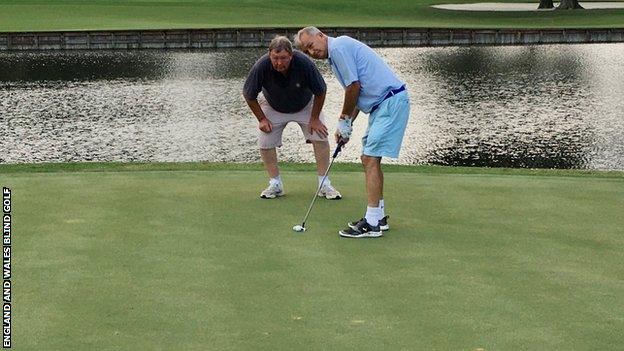Vision Cup: TPC Sawgrass to host Ryder Cup style event for blind golfers
- Published

John Eakin putting on the 17th green at Sawgrass in a practice round with his guide Steve Killick lining up the shot
"I expect we'll reach the greens reasonably easily at Sawgrass but then take ages putting."
England's John Eakin is registered blind and will this week captain the Rest of the World team against North America in the fifth Vision Cup.
The famed Florida course, which is renowned for its par-three island hole, plays host to this week's two-day Ryder Cup style event, with the teams of 14 blind golfers competing against each other in a match play format.
It was first contested in 2013 and Eakin has been on the winning team in three of the four previous contests, with the Rest of the World team retaining the title in the other.
"They've got some good players, but then so have we," says Eakin. "It's competitive but part of it has been the fun of meeting other visually impaired golfers and I wish for everyone to play well. If we lose, so be it."
Eakin, who is 64, started to lose his sight in his late 40s and now has just 10% of his central vision. He played off a handicap of three at his best with full sight but now plays off an amazingly respectable 10.
He says he was "somewhat depressed and unpleasant to live with" when his sight first began to fail. "I gave up golf for about a year, although my wife will tell you it was more like four weeks," Eakin says with a smile.
But then he found England and Wales Blind Golf,, external an organisation that he says has been "a great source of comfort" over the years. There are "around 50 members" according to Eakin but the biggest issue is attracting guides and spotters.
Blind golf is a team game. Each player relies on a guide to line up the shots, place the clubhead behind the ball, give yardage distances and describe the surroundings. Spotters do just that, keeping an eye on wayward shots. There has been a recent push to recruit more to the game.
There are three categories - B1 players have no light perception in either eye, or light perception but an inability to recognise shapes at any distance or in any direction. B2 and B3 players have a low level of partial vision, with B2 players being worse than B3.
The teams at the Vision Cup, which starts on Tuesday and has been organised by the United States Blind Golf Association, will contain four golfers in each of the B1, B2 and B3 categories and two women. Eakin's side will feature four players from England, three from Scotland and others from South Africa, Australia, Austria and Israel, while the North American side will be selected from Canada, USA, Costa Rica, Dominican Republic and Mexico.
Eakin, who has been a member of Royal Ashdown Forest in East Sussex for 35 years - including a year as captain in 2014 - is in the B3 category.
I am sitting six feet from him and he says my face is white and a complete blur. When I ask what he can see of the ball, he laughs as he says: "I've got an advantage. The blurring makes the ball slightly bigger."
While he knows his way round his home course, he still needs a guide and emphasises that the relationship between the two is crucial to their success.
"It's helpful if they have a good golfing knowledge but not essential," he says, before adding that his wife, who "hates golf" has guided for him "and thinks it's hilarious when I lose my temper".
Chris Vaughan is his usual guide but Steve Killick, who has guided Eakin several times, will be on hand in Florida. "Chris is always quiet when I hit a bad shot but Steve usually laughs," he adds. "I'm comfortable with both."
When it comes to guidance about the shot he faces, Eakin says "sometimes it's better to not know everything".
I referred specifically to the par-three 17th at Sawgrass - a 132-yard hole played completely across water to an island green - a shot that even the best golfers on the planet fear. All matches will start on the 10th hole so that the players will get the opportunity to tackle the iconic hole.
"So much is in your head," Eakin says. "I sometimes feel it's a waste of time to know everything. A lot of B1 players tend to want to know too much but it's something you have to decide with your guide."
The hardest shot for a blind golfer? "Some blind golfers hate water but I think rough is more difficult," he replies.
"If your ball lands in water, it's a simple drop. With rough it's hard to hit your ball out. There is a lot of heather on my course, so now I just drop my ball and play to my abilities.
"But the hardest shot, sadly, is putting.
"I can see the ball but I can't tell if the putter face is open or closed at impact. And I can't distinguish subtle slopes on the greens. So I'm reliant on my guide and pacing out putts. If it's 12-foot and downhill, my guide might say it's a six-foot strength putt.
"That's why Sawgrass will be so difficult. We'll reach the greens in two or three shots and I suspect then take many more."